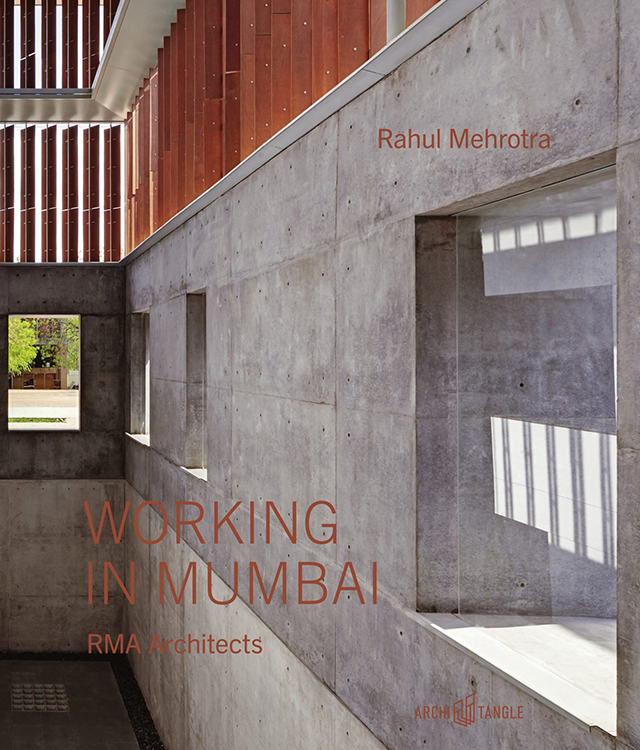Working in Mumbai
Working in Mumbai: RMA ArchitectsRahul Mehrotra; edited by Kate Cahill, with photographs by Rajesh VoraArchiTangle, July 2020Hardcover | 10 x 11-1/2 inches | 352 pages | 1,200 illustrations | English | ISBN: 978-3966800075 | 58.00 €PUBLISHER'S DESCRIPTION: Working in Mumbai is a critical reflection on thirty years of the practice of RMA Architects. Rahul Mehrotra weaves a narrative to connect his multiple engagements in architectural practice, including teaching, research, documenting, writing and exhibiting since the establishment of the practice in 1990. The book is structured around the subjects of interior architecture, critical conservation, and work and living spaces that straddle the binaries of the global and the local as well as the rural and the urban. While the book is a portfolio of the selected works of RMA Architects, the projects are curated so as to unravel and clarify the challenges faced by architects in India and in several parts of the “majority” world where issues related to rapid urbanization and the impacts of global capital are among the many that dispute conventional models of practice. Working in Mumbai is used emblematically to interrogate the notion of context and understand how the practice evolved through its association with the city of Bombay/Mumbai. REFERRAL LINKS: dDAB COMMENTARY: I've yet to venture to India, meaning I've yet to see in person one of the buildings designed by Rahul Mehrotra and his firm RMA Architects. (My best bet might be getting a peek at their Lab of the Future on Novartis's Basel campus on my next visit to Switzerland.) Nevertheless, I did see one of RMA's exhibitions, their award-winning contribution to the 2018 Venice Architecture Biennale. "Soft Thresholds" displayed images of three RMA buildings (KMC Corporate Office, Hathigon Housing, and CEPT University Library) that embody their desire to "create spaces of inclusiveness, exchange and empathy." Most interesting was the approach of suspending in space large photos printed on fabric scrims, in effect creating narrow, layered passages akin to the exhibit's title and giving visitors a more embodied sense of their buildings. Those three buildings are accompanied by dozens of others in this not-a-monograph by Rahul Mehrotra. I'd call it a monograph, but Mehrotra calls the presentation of RMA's work (first spread below) "a critical reflection on thirty years of practice — building, documenting, writing, exhibiting, and teaching." Mehrotra founded his eponymous firm in Mumbai in 1990 (it was re-formed as RMA Architects in 2010) but now maintains offices there and in Boston, where he spends part of his time as Director of the Master of Architecture in Urban Design Degree Program, among other positions, at the Harvard University Graduate School of Design. Even with a global practice, most of RMA's work is firmly situated in India; Mehrotra's books, such as Architecture in India: Since 1990 and Kumbh Mela: Mapping the Ephemeral Mega City, have the same geographical focus. In turn, that "critical reflection" is most valuable relative to the urban contexts of India, mainly Mumbai. Working in Mumbai presents RMA's output in four thematic chapters (Architecture of the Interior, Between the Rural and the Urban, Constructing Cultural Significance, and Mediating the Local and the Global) that basically coincide with established architectural typologies: respectively art and retail spaces; houses; conservation projects; and workplaces and institutions. (These links indicate RMA's website follows a similar structure.) Inadvertently, perhaps, these chapters also work somewhat chronologically, given that Mehrotra's earliest projects were interior renovations and recent work has been institutional in nature. Each chapter starts with a fairly long essay (they feel long, at least, with the large page size and three columns of text per page) that sees Mehrotra reflecting critically on his practice and the places where he works. The projects that follow are described primarily through images — approximately 1,200 in the whole book! A fifth chapter, Context as Generator of Practice, effectively serves as a conclusion to the book by articulating RMA's way of using Mumbai as "a laboratory" and "generator of practice" (fourth spread below). This essay segues into the back matter, which exhaustively documents RMA's projects and Mehrotra's publications, exhibitions, and teaching. Kudos goes to M1DTW for putting the massive amounts of text, images, and data into a cohesive and beautiful package that is enjoyable to peruse and absorb. At first I was disappointed by the matte paper, since the photos don't pop as much as they would on glossy paper, but this choice makes the book much lighter while also working well with RMA's buildings, which are modern yet also soft, as the 2018 exhibition alludes. Monograph or not, it's an amazing book on an architecture practice that deserves a lot of attention — in and beyond Mumbai.

Working in Mumbai: RMA Architects
Rahul Mehrotra; edited by Kate Cahill, with photographs by Rajesh Vora
ArchiTangle, July 2020
Hardcover | 10 x 11-1/2 inches | 352 pages | 1,200 illustrations | English | ISBN: 978-3966800075 | 58.00 €
PUBLISHER'S DESCRIPTION:
SPREADS:









